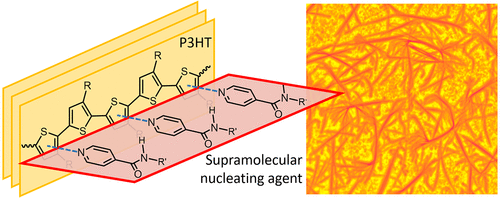
New publication! 🎉 A longstanding collaboration with the group of Prof. Hans-Werner Schmidt in Bayreuth published exciting results in Macromolecules:
Wenzel, Felix A. et al. “Highly Efficient Supramolecular Nucleating Agents for Poly(3-hexylthiophene).” Macromolecules 2022, 55, 7, 2861–2871.
For everyday plastics, nucleating agents are a valuable ingredient to reduce the product’s processing time, or to clarify the material [1]. As such, nucleating agents are routinely employed in the production of mundane things like lunch boxes and plastic bottles. However, for functional conjugated polymers (a material class that is used for optoelectronic devices such as OLEDs or organic solar cells), there’s still a lack of good nucleating agents, which limits our control over the microscale film morphology, which is an important factor for device performance [2].
In our publication, we present an extemely efficient nucleating agent for the famous polymer Poly(3-hexylthiophene) (in short: P3HT). The compounds’s chemical structure perfectly matches P3HT’s crystal structure (see below), so that local electronic push/pull interactions assist P3HT’s crystal growth.

Figure: The good structural match between nucleating agent and P3HT supports P3HT’s crystallization. Right: Polarization micrograph of trans-crystallized P3HT. Adopted without changes from Felix A. Wenzel et al., ACS Publications.
Using hyperspectral imaging, I compared the fluorescence response of thin P3HT films prepared with and without nucleating agent. Our setup’s spatial resolution of about 500nm (Abbe limit) allows us to uncover inhomogeneities in the local optical response of the films, such as impurities of various kinds. However, the lack of such local inhomogeneities indicates that the nucleating agent disperses well within the material, and should be readily applicable in solution-processing for organic optoelectronic devices.
-
“Designer” Nucleating Agents for Polypropylene, Markus Blomenhofer, Sandra Ganzleben, Doris Hanft, Hans-Werner Schmidt, Magnus Kristiansen, Paul Smith, Klaus Stoll, Dietmar Mäder, and Kurt Hoffmann. Macromolecules 2005 38 (9), 3688-3695 ↩︎
-
The Next Breakthrough for Organic Photovoltaics?, Nicholas E. Jackson, Brett M. Savoie, Tobin J. Marks, Lin X. Chen, and Mark A. Ratner. The Journal of Physical Chemistry Letters 2015 6 (1), 77-84 ↩︎




